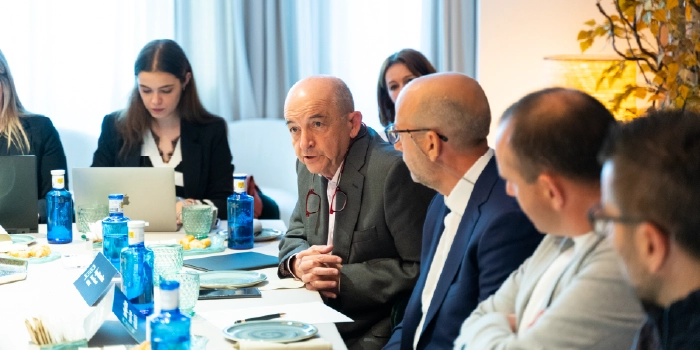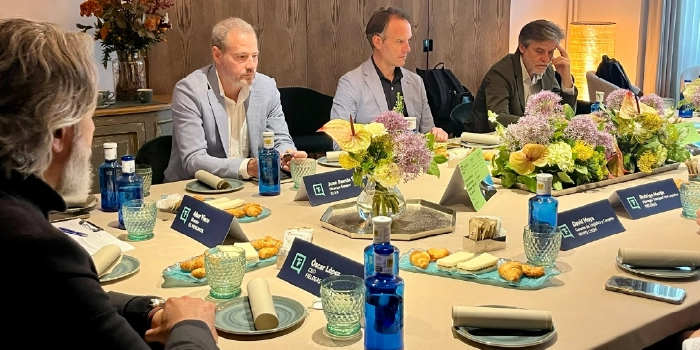The ecosystem concept in the digitalization of road freight transport
2º FIELDEAS Talks "An old formula for the new times: veni vidi vici…signum"


FIELDEAS has held the second edition of FIELDEAS Talks, a series of events aimed at unraveling the role of digitalization in road, rail, maritime and air freight transport, as well as in the logistics sector.
In this second meeting, different transport and logistics managers have analyzed in depth the degree of digitalization of the road freight transport sector, as well as the main challenges and opportunities around technological applications.
All professionals agreed that digitalization is the biggest challenge for road freight transport, although they recognized the key role of technological solutions to gain visibility, save costs and improve operations.
“I think there is a lot to be done in terms of digitization and visibility, but it is certainly an opportunity for cost savings and improved information,” stressed Choví Group Logistics and Purchasing Manager David Moya.
The first part of this meeting focused on the keys to ensuring end-to-end visibility of the supply chain. “Digitalization and visibility are simple in the short distance, the problem is in long and complex supply chains,” said Pascual Logistics Director, Pedro Marín.
The first barrier encountered has to do with reticence to change and the outsourcing chain. The professionals have shown that the very configuration of the sector, highly atomized, slows down digitalization in road freight transport.

“The problem has to do with the structure of the sector. We have to be aware that digitalization has to be done down to the last scale in order not to lose visibility,” said Ontime’s CEO, Ángel González.
As a solution, managers are committed to training to ensure that digitization reaches all the way to the bottom of the ladder and that visibility is not lost. In fact, they emphasize that digitization must serve to have greater control over the subcontracting chain and over unfair competition.
“It is important to invest in digitalization and, above all, in staff training, which for me is the key issue,” said Juan Miguel Dasca, CEO of Alianza Logistics.
Another solution proposed by the managers of some of the leading companies in the transport and logistics sector to provide visibility throughout the chain is to build loyalty among transport suppliers. In this way, the percentage of spot charge is minimal and, on the other hand, the percentage of use of digitization tools is very high.
“The loyalty of transport suppliers is what allows you to count a high percentage of the use of digitization tools,” emphasized Capsa Food’s Logistics Director, Roberto Garcia.
For his part, the director of El Mercantil, Aitor Vieco, pointed out that “loyalty is key to achieving a digital ecosystem in the sector”.
Another problem encountered on the road to digitalization in road freight transport is the lack of integration between the different technological solutions. “If we are not able to integrate, it will be difficult for us to provide the visibility that is being demanded of us,” said Juan Ramón Serrano, general manager of ROR Operador Logístico.
To solve this barrier, the sector urges the Public Administration and technology companies to create standards that allow homogenizing the entire digitization process in road freight transport.

In this sense, the CEO of FIELDEAS, Óscar López, pointed out that the problem of visibility is not a problem of the system, but of the ecosystem.
For Óscar López, this ecosystem concept must be implemented in all actors in the chain, with two aspects:
“We must implement the concept of digital ecosystem in the road transport sector, where there is a balance and where everyone wins and integration between systems is favored,” said FIELDEAS CEO Óscar López.
He also pointed out that it is not only the technological aspect that is important when integrating a solution, but also the support.
For example, at FIELDEAS we employ a four-step strategy in any project we initiate:
In addition, we establish KPIs to measure each of these steps so that the system integration is successful and enduring.
“The key is to offer a simple tool that covers any scenario. Let’s not use technology to be restrictive, but to give options,” said FIELDEAS Transport and Logistics manager, Rodrigo Martin.
The importance of gaining end-to-end visibility into any supply chain lies in automation. As Óscar López, CEO of FIELDEAS, explained, automation is where the real added value, cost savings and efficiency lie.

Within this concept of digital ecosystem, it is essential to understand that by obtaining visibility from different sources of information, all players in the sector can automate their processes. It must be useful for the shipper to optimize dock management, but also for the carrier to invoice earlier and to have fewer conflicts. “By offering visibility you are offering the other to automate their operational and administrative processes.”
In spite of the great progress made by the regulations on loading and unloading work in terms of improving drivers’ working conditions, the sector is experiencing an increase in times and considers that there is a loss of added value in those companies that are qualified to carry out loading and unloading work.
In order to optimize times, platforms are betting on the integration of loading and unloading management systems and unloading management systems that allow exhaustive control of schedules and bookings.
Giving visibility to dock management means gaining flexibility and thus becoming more efficient.
Moreover, with this type of technological solutions it is possible to involve all the agents involved and allow the driver himself to reserve the slot according to his time and needs.

Another key point on the road sector’s digitalization path is document management.
Despite popular belief, there is already a legal and regulatory guarantee for the digitization of transport documents, both at national and EU level.
In this regard, during the meeting, a detailed explanation was given about the regulation linked to the electronic transport document (eCMR, control document or delivery note) (eCMR, control document or delivery note) and the importance of having an advanced electronic signature throughout the process.

On the other hand, the industry is calling for a platform that includes all the necessary modules to gain complete visibility throughout the supply chain, from document management to dock management, route optimization and carbon footprint calculation. FIELDEAS Track and Trace is an “only one” that already offers this integral solution to the market and also accompanies its customers throughout the entire changeover process.
By way of conclusion, the CEO of FIELDEAS emphasized that the entire supply chain has the will or intention to achieve this visibility in order to automate and thus become more efficient. He also stressed that “the value behind digitalization in road freight transport is much greater than the small handicaps that surround this change and this transformation”.


01 Apr 2024
The implementation of electronic CMR in transport

20 Mar 2024
Collaborative digital solutions to optimise transport management

09 Apr 2024
8 benefits of optimize loading and unloading dock management

11 Apr 2024
eCMR or electronic consignment note, why implement it?